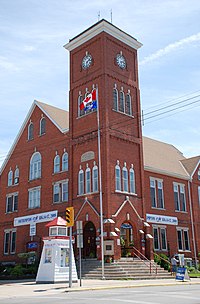Saugeen Shores, Ontario
| Saugeen Shores | |
|---|---|
| Town (lower-tier) | |
| Town of Saugeen Shores | |

Old town hall, Southampton
|
|
| Location in southern Ontario | |
| Coordinates: 44°26′N 81°22′W / 44.433°N 81.367°WCoordinates: 44°26′N 81°22′W / 44.433°N 81.367°W | |
| Country |
|
| Province |
|
| County | Bruce |
| Settled | ca. 1849 |
| Formed | 1996 |
| Government | |
| • Mayor | Mike Smith |
| • Deputy Mayor | Luke Charbonneau |
| • Vice Deputy Mayor | Diane Huber |
| • Federal riding | Huron—Bruce |
| • Prov. riding | Huron—Bruce |
| Area | |
| • Land | 171.05 km2 (66.04 sq mi) |
| Population (2016) | |
| • Total | 13,715 |
| • Density | 80.2/km2 (208/sq mi) |
| Time zone | EST (UTC-5) |
| • Summer (DST) | EDT (UTC-4) |
| Postal Code | N0H |
| Area code(s) | 519 and 226 |
| Website | www |
Saugeen Shores is a town in Bruce County, Ontario, Canada, formed in 1998. (The name "Saugeen" is the corrupted form of the word Zaagiing in the language of the Chippewas of Saugeen Ojibway Territory, meaning "at the river's outlet" or "at the mouth of the river".)
On January 30, 1998, the provincial government amalgamated Southampton, Port Elgin and Saugeen Township, all along the shores of Lake Huron, to form the Town of Port Elgin-Saugeen-Southampton. On December 17, 1998, the Province renamed the entity as the Town of Saugeen Shores.
The primary employment categories are agriculture, small business, tourism and work at the Bruce Power nuclear power station. The population doubles in the summer due to cottagers and campers who arrive in the area. Close to MacGregor Point Provincial Park, the town has several beaches on Lake Huron.
In addition to the two main population centres of Southampton and Port Elgin, the town includes a portion of the village of Burgoyne and the North Bruce area, straddling the municipal eastern and southern boundary respectively. In 2016, the permanent population of Saugeen Shores was 13,715, in a land area of 171.05 square kilometres.
The area that is now Port Elgin was settled by Europeans in 1849, when Lachlan McLean ("Loch Buie") built a shanty and lived in it for the winter. For several years he ran a tavern, his patrons consisting primarily of settlers and sailors passing through the little port. In spring 1852 George Butchart built a dam and saw-mill on Mill Creek.
According to an Ontario historic plaque, Butchart sold the mill to Benjamin Shantz who built a grist-mill, and within three years a community of 250 people had developed around these mills. Stores, hotels and tanneries were constructed and in March 1857, a village plot named Port Elgin was laid out. The enterprise of its businessmen, notably Henry Hilker, Samuel Bricker and John Stafford, contributed to the development of the settlement, which had a population of over 600 by 1867. The arrival of the Wellington, Grey and Bruce Railway in 1872 further stimulated the growth of the community and it was incorporated as a village in 1874 with a population of about 950." By 1854, the community had three houses, a tavern, and mill. Shops, churches, schools, and roads followed, and ten years later the population totalled six hundred and thirty. Early industries included a steam sawmill, foundry, and woolen mill. In 1873, the railway arrived, allowing Southampton and Port Elgin products to travel out into the world.
...
Wikipedia

